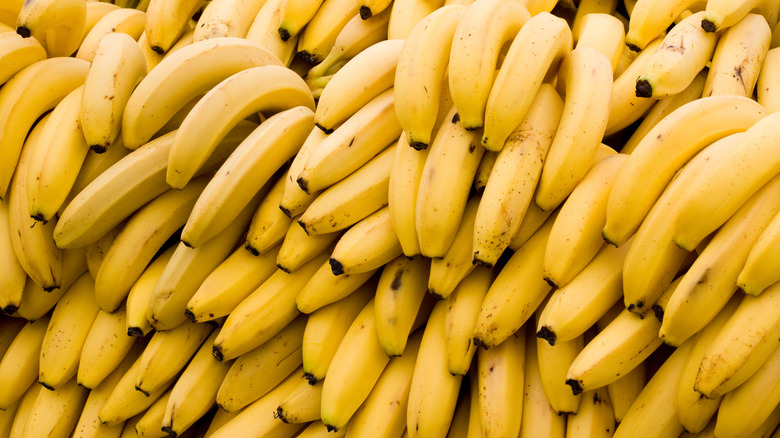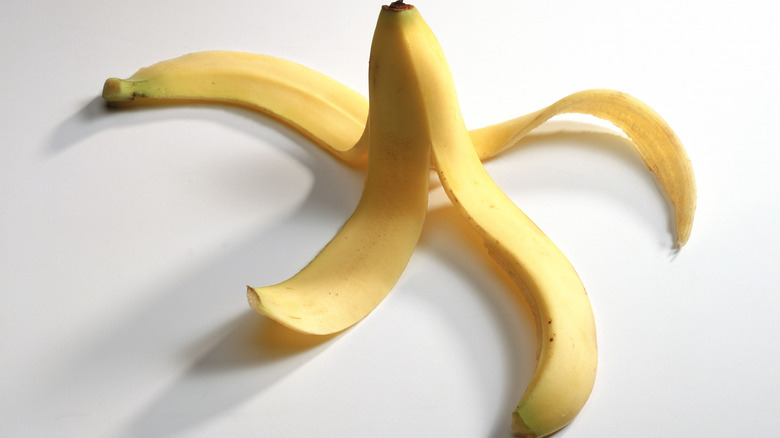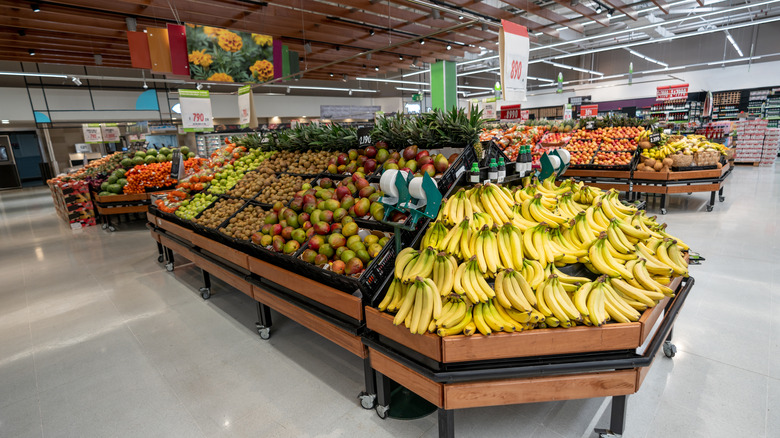One Country Produces The Most Bananas Worldwide By A Landslide
Americans love bananas. No fresh fruit is more commonly purchased at supermarkets, according to Statista. But U.S. residents don't even come close to eating the most — at least based on per capita consumption figures — nor do its farmers rank near the top in terms of production.
The two countries that grow the most are in Asia: India and China (per World Population Review). But even those two countries' production levels aren't comparable. India cultivates more than two-and-half-times the amount, harvesting over 30 million tons annually. China, by contrast, accounts for 12 million tons of bananas (and also produces the most watermelons in the world). Indonesia, Brazil, and Ecuador round out the top five for banana production, with the latter two nations leading the way in the Western Hemisphere, growing 6.8 and 6.6 million tons, respectively. The U.S., meanwhile, is not a top 10 producer and doesn't even crack the one 1 million ton mark.
Why does India grow so many bananas? It has the most land devoted to the crop with more than two million acres — and much of the country boasts the desired fertile soils and tropical climate needed (most bananas are grown between 0 and 30 degrees of latitude north and south of the equator). Rather surprisingly, considering its outsized production, India is not a major exporter. Its massive banana crop is mostly consumed domestically.
A short history of bananas
The banana is one of the oldest fruits on the planet, with the earliest examples dating back nearly 10,000 years. Southeast Asian countries like Indonesia, Malaysia, and the Philippines were among the first places the fruit took root, and these countries are all still notable producers.
Bananas were grown in India by 600 B.C., but weren't introduced to China until about 200 A.D. Still, both of today's top-producing-countries have a lengthy history with the crop. From its beginnings in Asia, bananas slowly made their way around the globe. Alexander the Great discovered the yellow fruit during an invasion of India, for example, and brought it to Europe. Bananas were also transported to the Middle East — the place where they were given their modern name — and reached Africa by the year 650. But it took another millennium before the crops were planted on a large scale in Latin America. That occurred between the 16th and 19th centuries.
The arrival of bananas in the U.S. is a relatively recent phenomenon. The fruit wasn't commonly consumed until the 1880s, with the first basic banana bread recipes appearing a half-century later during the Great Depression.
Where the bananas in American supermarkets come from
Despite the fact that the U.S. is not the largest per capita consumer of bananas (that honor belongs to Uganda), it's the world's largest importer, sourcing nearly $3 billion worth of the fruit annually. However, neither India nor China, the two largest producers worldwide, contribute many of the bananas and plantains (yes, there's a difference) sold in American supermarkets. The bananas we eat in this country are primarily imported from Mexico and Central America.
Guatemala, for example, is by far the largest exporter of bananas to the U.S., sending over $1 billion of the crop in 2022. Ecuador, Honduras, Costa Rica, and Mexico are the next biggest suppliers, in that order.
The U.S. also managed to rank 11th in the world as an exporter in 2022, with Canada being the largest market for homegrown bananas. Hawaii, one of few U.S. states that falls within the tropical climate zone, produces most of the nation's bananas, but South Florida is also a growing area. The Cavendish, the most popular of approximately 1,000 banana varieties grown worldwide, is a favorite in the U.S. as well, with the apple banana being the only other commonly produced variety.



